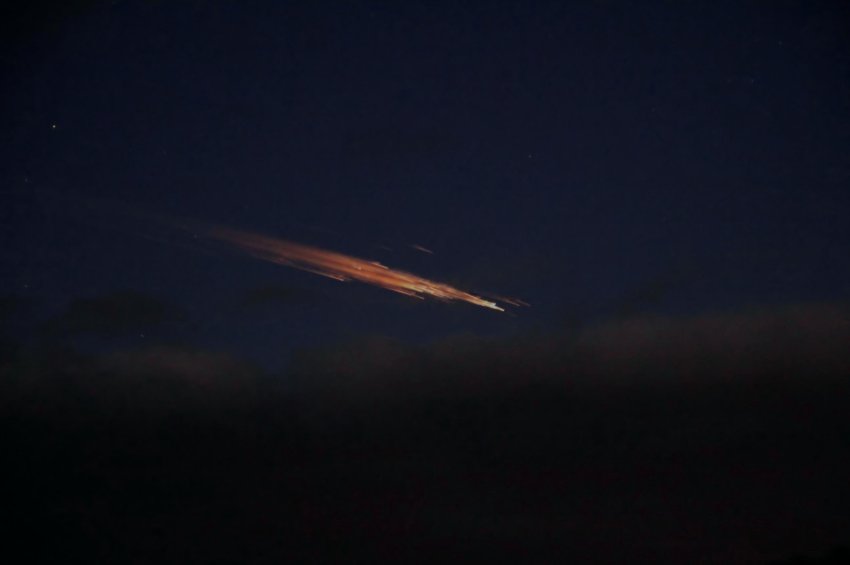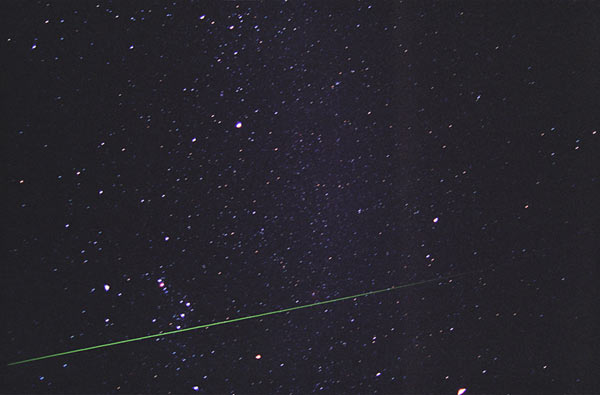It looks like you're using an Ad Blocker.
Please white-list or disable AboveTopSecret.com in your ad-blocking tool.
Thank you.
Some features of ATS will be disabled while you continue to use an ad-blocker.
share:
Originally posted by ahamarlin
Wouldn't a extremely hot meteor(ite) glow light orange, burning up in the earth atmosphere?
No, not necessarily.
The light that we see from an object entering the atmosphere (natural or artificial) comes from a cloud of ionized particles that surround the object. The cloud is a mixture of mostly ionized atmospheric gases, and bits of the object that have been stripped away by the process of "ablation".
It's a general misconception that meteoroids "burn up" in our atmosphere. They don't. Ablation and ionization, primaraly due to the extreme velocity, are the reason light is emmited.
The colours observed will depend on a combination of factors:
Firstly, what elements are ionized. Each has a characteristic colour/wavelength/"emission line".
Oxygen for example, when ionized emits light at green wavelengths, and it's not just a dull/pale green. It's so vivid in some cases, that it looks un natural, perhaps even prompting some to think that they saw a "UFO".
Here for example (and sorry for re-posting this pic to all who have seen it before), is a photograph I took of a green earth grazing Leonid meteor during the build up to the Leonid meteor storm of 2001.
Orion is in the bottom left of the image, to give it some scale.
One feature that destinguishes earth grazers from normal meteors is how long they are, and that is because they are grazing the edge of our atmosphere, and in some cases, going back out into space again.
Normal (non earth grazing) meteors on the other hand, are heading towards the observer and plunging into the atmosphere at a steep angle, so they ablate much faster as well as looking much shorter due to perspective.
Interestingly, although oxygen is scarce at around 100km altitude (roughly where meteors first become visible), it's makes up the greatest percentage of gas at that altitude, and is the reason why such a long meteor is all green, where as other photographs taken on the same night show meteors that start out green, going on to yellow, and then orange/red if the meteor survives long enough.
Can fireballs appear in different colors?
Vivid colors are more often reported by fireball observers because the brightness is great enough to fall well within the range of human color vision. These must be treated with some caution, however, because of well-known effects associated with the persistence of vision. Reported colors range across the spectrum, from red to bright blue, and (rarely) violet. The dominant composition of a meteoroid can play an important part in the observed colors of a fireball, with certain elements displaying signature colors when vaporized. For example, sodium produces a bright yellow color, nickel shows as green, and magnesium as blue-white. The velocity of the meteor also plays an important role, since a higher level of kinetic energy will intensify certain colors compared to others. Among fainter objects, it seems to be reported that slow meteors are red or orange, while fast meteors frequently have a blue color, but for fireballs the situation seems more complex than that, but perhaps only because of the curiosities of color vision as mentioned above.
The difficulties of specifying meteor color arise because meteor light is dominated by an emission, rather than a continuous, spectrum. The majority of light from a fireball radiates from a compact cloud of material immediately surrounding the meteoroid or closely trailing it. 95% of this cloud consists of atoms from the surrounding atmosphere; the balance consists of atoms of vaporized elements from the meteoroid itself. These excited particles will emit light at wavelengths characteristic for each element. The most common emission lines observed in the visual portion of the spectrum from ablated material in the fireball head originate from iron (Fe), magnesium (Mg), and sodium (Na). Silicon (Si) may be under-represented due to incomplete dissociation of SiO2 molecules. Manganese (Mn), Chromium (Cr), Copper (Cu) have been observed in fireball spectra, along with rarer elements. The refractory elements Aluminum (Al), Calcium (Ca), and Titanium (Ti) tend to be incompletely vaporized and thus also under-represented in fireball spectra.
Source: The American Meteor Society
Continued in the following post...
edit on 24-12-2011 by C.H.U.D. because: typo
Secondly, individual peception also plays a part in what colors are observed believe it or not. Ask 10 people what color they saw, and you'll get 10
different answers in many cases.
Here is just a small part of a discussion that has gone on at lengh on the meteor observing list, and I think is representative of the general opinion of the scientific community.
Source: The Meteor Observing Mailing List (METEOROBS)
A quick search of METEOROBS will give you more info on the subject.
Here is just a small part of a discussion that has gone on at lengh on the meteor observing list, and I think is representative of the general opinion of the scientific community.
We know (scientifically) that the human eye color system is most sensitive in the green part of the spectrum. But witnesses see that as well as many other colors. And everyone’s perception of color is different. And most fireball witness reports are from people who are reporting a unique event in their life. Experienced meteor observers who, side by side, watch the same meteors report different colors. We know from meteor spectroscopy that green lines are part of the spectrum, but so are many others.
Source: The Meteor Observing Mailing List (METEOROBS)
A quick search of METEOROBS will give you more info on the subject.
reply to post by ahamarlin
Here is another great picture.
I really wish I had seen this event myself.

Source
Here is another great picture.
I really wish I had seen this event myself.

Source
edit on 25-12-2011 by derpif because: (no reason
given)
Originally posted by ahamarlin
Around 17.30 hours local time this video is made. It looks to me there is a big solid object in front of the tail.
Doesn't look like a normal piece of rock/ice.
I am not very familiar with falling stuff out of space, what you guys think?
Okay so explain to me WHY we are speaking of meteorites and making wild guesses when the TITLE of the video says..
Sojoez-raket over Nederland Which means Soyuz Rocket
Furthermore in the description of the video....
Rond half zes vloog er iets over Nederland, Is het een komeet of meteoriet? Het bleek om een deel te gaan van de Sojoez-raket die Andre Kuipers naar de ISS heeft gebracht.
Which a simple translation using google translate shows...
Around five thirty something flew over the Netherlands, is it a comet or meteorite? It turned out to be a part of the Soyuz rocket that Andre Kuipers to the ISS has been.
An other video of the same event ?
edit on 25-12-2011 by jaamaan because: (no reason given)
Originally posted by zorgon
Okay so explain to me WHY we are speaking of meteorites and making wild guesses when the TITLE of the video says..
I think most people would not know the difference between a metorite dropping fireball and a junk reentry, and that is understandable since they are very similar in appearence in at least some cases, and the physics is also applicable to both, so it makes good sense to use them as an example/discuss the aspects that they have in common.
I also think meteorites are a good example for this reason, and because they are more frequent than junk reentries, so from a scientific standpoint, they have been studied in at least as much detail as reentries, if not more.
As an example, here is footage of the peeksill fireball, which famously dropped meteorites on the ground, one of which ended up embedded in a car.
Compare that to the reentry we have been talking about here, and the excellent footage that jaamaan posted above (which does indeed look like a video of the same event we have been discussing).
Aside from the colour, there is little if any apparent difference IMO.
The un-apparent difference in this case is that (as you rightly pointed out) we have a confirmed candidate for the origin of this object - the Soyuz rocket launch.
Originally posted by zorgon
Originally posted by ahamarlin
Around 17.30 hours local time this video is made. It looks to me there is a big solid object in front of the tail.
Doesn't look like a normal piece of rock/ice.
I am not very familiar with falling stuff out of space, what you guys think?
Okay so explain to me WHY we are speaking of meteorites and making wild guesses when the TITLE of the video says..
Sojoez-raket over Nederland Which means Soyuz Rocket
Furthermore in the description of the video....
Rond half zes vloog er iets over Nederland, Is het een komeet of meteoriet? Het bleek om een deel te gaan van de Sojoez-raket die Andre Kuipers naar de ISS heeft gebracht.
Which a simple translation using google translate shows...
Around five thirty something flew over the Netherlands, is it a comet or meteorite? It turned out to be a part of the Soyuz rocket that Andre Kuipers to the ISS has been.
Zorgon,
the youtube video title is edited. By the time it came online nobody knew what is was.
I know cause I speak Dutch (no need for google translations)
But sorry if I wasted your time. Now instead of being grumpy, why don't you provide us with one of your (moon) threads. Whats new and mysterious?
Greetings from a fan, and Oh....if you see John, please ask him to come back. ....please.
Another recording of the event has emerged. Cretit goes to
Mianeye for finding it.
Link: www.liveleak.com...
Link: www.liveleak.com...
new topics
-
'Mass Casualty event' - Attack at Christmas market in Germany
Mainstream News: 1 hours ago -
Search to Resume for MH 370
Disaster Conspiracies: 3 hours ago -
Sue Gray, Sir Keir Starmer's former Chief of Staff, Nominated for Peerage
Regional Politics: 4 hours ago -
Biden Nationalizes Another 50,000+ Student Loans as He Heads for the Exit
US Political Madness: 5 hours ago
top topics
-
'Mass Casualty event' - Attack at Christmas market in Germany
Mainstream News: 1 hours ago, 15 flags -
An Interesting Conversation with ChatGPT
Science & Technology: 15 hours ago, 8 flags -
Biden Nationalizes Another 50,000+ Student Loans as He Heads for the Exit
US Political Madness: 5 hours ago, 7 flags -
Sue Gray, Sir Keir Starmer's former Chief of Staff, Nominated for Peerage
Regional Politics: 4 hours ago, 2 flags -
Search to Resume for MH 370
Disaster Conspiracies: 3 hours ago, 2 flags
active topics
-
'Mass Casualty event' - Attack at Christmas market in Germany
Mainstream News • 14 • : NorthOS -
Can someone 'splain me like I'm 5. Blockchain?
Science & Technology • 90 • : Ravenwatcher -
Russias War Against Religion in Ukraine
World War Three • 54 • : andy06shake -
Search to Resume for MH 370
Disaster Conspiracies • 3 • : chr0naut -
Drone Shooting Arrest - Walmart Involved
Mainstream News • 36 • : imitator -
-@TH3WH17ERABB17- -Q- ---TIME TO SHOW THE WORLD--- -Part- --44--
Dissecting Disinformation • 3768 • : Thoughtful3 -
Have you noticed?? Post Election news coverage...
World War Three • 10 • : chr0naut -
An Interesting Conversation with ChatGPT
Science & Technology • 21 • : Flyingclaydisk -
US Federal Funding set to Expire December 20th. Massive CR on the way.
Mainstream News • 45 • : marg6043 -
Biden Nationalizes Another 50,000+ Student Loans as He Heads for the Exit
US Political Madness • 5 • : Dalamax

